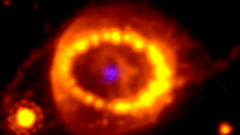31 minutes ago
About sharing
Scientists say they have solved the mystery of what lies at the heart of a celebrated cosmic explosion.
In February 1987, a star exploded in a neighbouring galaxy. It was visible from Earth for four months, shining with the power of 100 million suns.
There was so much debris, even the most powerful telescopes could not confirm what remained at its heart.
New results confirm it is a neutron star, so dense that a teaspoon of it would weigh 10 million tonnes.
BBC Sky at Night presenter Dr Maggie Aderin-Pocock said that the research team had “solved a murder mystery”.
“It is about the death of a star and the mystery has been what lies in the shrouds of dust around what remains,” she said.
The explosion was of a huge star, 20 times the mass of our Sun, a so-called blue supergiant. Its life ended in spectacular style in a process called a supernova, prosaically called SN 1987A, by astronomers. It was the first supernova to have been visible to the naked eye for 400 years, and was from a star whose details had been captured and recorded by astronomers before it exploded.
Dr Aderin-Pocock once worked on a project to solve the puzzle of SN 1987A, which she says was figuratively, as well as literally, a big star.
“The fact that it was visible gave it a celebrity status outside the world of science. And SN 1987A is also very close to the heart of astronomers because it was relatively close, and they were able to capture so much detail of the star’s life cycle.”
The observations made SN 1987A the ideal lab in the sky to check the details of the theories of how stars die. But there has been a critical piece of the puzzle missing – what was left at its heart after such a cataclysmic event.
According to the theory, stars collapse when they run out of fuel to carry out the nuclear reactions that make them shine. The mass of the star is so great that its gravitational force crushes its own atoms to produce the densest material in the Universe, which is called a neutron star, or if it is a larger star, it can become a black hole.
But which one was it? This is important for astronomers to know, because supernovas spread elements that form life across the Universe.
Researchers writing in the journal Science say they have strong if not overwhelming evidence that it is a neutron star.
Prof Claes Fransson, of Stockholm University in Sweden, who led the study, said this was the first time anyone had been able to probe the centre of the supernova and what was created there.
“We now know that there is a compact source of ionising radiation, most likely by a neutron star. We have been looking for this from the time of the explosion but had to wait to be able to verify the predictions.”
The new data indicates that the surface of the neutron star would be about a million degrees, having cooled down from 100 billion degrees or so.
Baby star
The team will continue to monitor the supernova area to learn more about the precise details of the explosion. And the data gives the team an opportunity to monitor a very early “baby” neutron star and compare it with older ones to see how these cosmic heavyweights evolve over time.
”If we’re lucky, then in the next few years we might even see the neutron star in the centre properly, getting a relatively close look at one of these intriguing objects very early in its life.”
The observations were made possible because of Nasa’s James Webb Space Telescope (JWST). As well as being the most powerful space observatory ever built, it has instruments that take measurements at infra-red frequencies and so can see past the space dust that has for so long blocked our view.
Prof Mike Barlow, of UCL, says although there have been several indirect hints, JWST has obtained “the first direct evidence” that it is a neutron star.
“The mystery over whether a neutron star is hiding in the dust has lasted for more than 30 years and it is exciting that we have solved it.”
Smoking gun
The JWST data was analysed by 34 scientists from 12 countries. They found light from atoms of the elements, argon and sulphur that could have only been produced by powerful radiation coming from a neutron star at the centre of the supernova. There is no direct image of the neutron star itself, but it would be hard for anything else to explain the readings, according to Dr Robert Massey, of the Royal Astronomical Society.
”If we’re lucky then in the next few years we might even see the neutron star in the centre properly, getting a relatively close look at one of these intriguing objects very early in its life.”
So although the astronomer detectives do not yet have the smoking gun, of the murder mystery, they do have the smoke from the gun.
19 November 2019
31 August 2023
